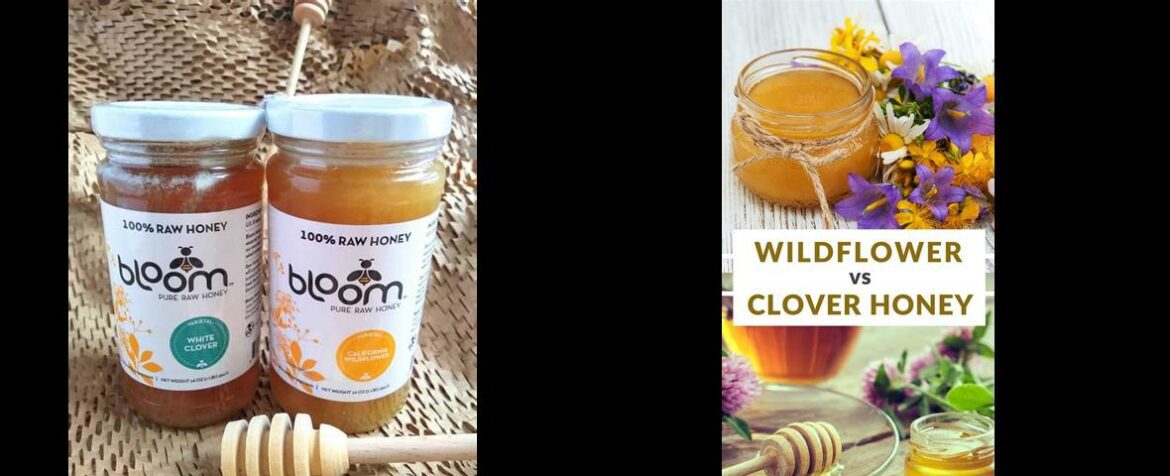Difference between clover and wildflower honey: Are you a honey lover searching for the perfect sweetener to drizzle over your morning toast or stir into your afternoon tea? Look no further! In this blog post, we’re going to dive deep into the delicious world of honey and explore the difference between two popular varieties: clover honey and wildflower honey. Get ready to tantalize your taste buds and discover the unique flavors and characteristics that set these sweeteners apart. So, grab a spoon and join us on this honey-filled adventure!
Clover Honey vs. Wildflower Honey: A Tale of Two Sweeteners
In the realm of natural sweeteners, honey stands tall as a culinary treasure, revered for its golden allure, delicate sweetness, and myriad health benefits. Among the diverse honey varieties, clover honey and wildflower honey occupy prominent positions, each boasting unique characteristics that set them apart. Embark on a journey to unveil the intricacies of clover honey and wildflower honey, delving into their distinct flavors, aromas, hues, textures, and culinary applications.
Clover Honey: A Symphony of Delicate Sweetness
Clover honey, a golden elixir derived from the nectar of clover blossoms, exudes a mild, sweet flavor with subtle floral undertones. Its captivating aroma, reminiscent of vanilla and blooming meadows, tantalizes the senses. This liquid gold, ranging from light amber to golden yellow in hue, possesses a velvety smooth texture, making it a delight to spread on toast or drizzle over pancakes.
Beyond its culinary charm, clover honey is a treasure trove of health-promoting compounds. Its rich antioxidant content combats free radical damage, shielding cells from oxidative stress. Furthermore, its antibacterial properties may aid in digestion and soothe sore throats.
Wildflower Honey: A Symphony of Robust Complexity
Wildflower honey, a symphony of flavors and aromas, captures the essence of diverse wildflowers. Bees gather nectar from a myriad of blossoms, resulting in a honey that bursts with a robust, complex flavor profile. Each batch of wildflower honey is unique, reflecting the specific blend of flowers visited by the bees. Its color, ranging from amber to dark brown, hints at its intense flavor.
Wildflower honey boasts an earthy, floral aroma, often accompanied by a hint of spice. Its texture, often coarse and grainy due to crystallization, adds a delightful chewiness. This honey is a perfect addition to yogurt, fruit salads, or drizzled over pancakes.
Just like clover honey, wildflower honey is a powerhouse of antioxidants and antibacterial compounds. It may also possess immune-boosting properties, supporting overall well-being.
A Comparative Glance: Unveiling the Differences
Clover honey and wildflower honey, while sharing the common thread of sweetness, diverge in several notable aspects:
Flavor:
- Clover honey: Mild, sweet, and subtly floral.
- Wildflower honey: Robust, complex, and varies with the flowers used.
Aroma:
- Clover honey: Vanilla and floral.
- Wildflower honey: Earthy, floral, with a hint of spice.
Color:
- Clover honey: Light amber to golden yellow.
- Wildflower honey: Darker, ranging from amber to dark brown.
Texture:
- Clover honey: Velvety smooth, easy to spread.
- Wildflower honey: Coarse, grainy, crystallized.
Culinary Uses:
- Clover honey: Versatile, great for baking, dressings, and marinades.
- Wildflower honey: Ideal for drizzling on pancakes, yogurt, or fruit. Also used in baking and marinades.
Choosing Your Honey: A Matter of Personal Preference
When selecting between clover honey and wildflower honey, personal preference reigns supreme. Consider the following factors to guide your choice:
- Flavor: Clover honey’s mild sweetness may appeal to those who prefer a delicate touch, while wildflower honey’s robust complexity might resonate with those seeking a more pronounced flavor experience.
- Culinary Application: Clover honey’s versatility makes it a suitable choice for baking, while wildflower honey’s bolder flavor lends itself well to savory marinades and glazes.
- Health Benefits: Both clover honey and wildflower honey offer antioxidant and antibacterial properties. Wildflower honey may have additional immune-boosting benefits.
Ultimately, the choice between clover honey and wildflower honey is a personal journey, guided by taste preferences and culinary aspirations.
Conclusion: Embracing the Sweet Diversity of Honey
Clover honey and wildflower honey, distinct in their flavors, aromas, and textures, offer a captivating exploration into the world of natural sweeteners. Whether you seek the delicate sweetness of clover honey or the robust complexity of wildflower honey, both varieties promise a culinary adventure that delights the senses and nourishes the body. Embrace the diversity of honey, allowing its golden allure and myriad flavors to enhance your culinary creations and promote overall well-being.
FAQ about Difference Between Clover And Wildflower Honey
Q: What is the difference between clover honey and wildflower honey?
A: Clover honey is derived from the nectar of clover blossoms, while wildflower honey is a combination of nectar from various wildflowers.
Q: How does clover honey taste?
A: Clover honey has a mild, sweet flavor with subtle floral undertones.
Q: What does clover honey smell like?
A: Clover honey has a captivating aroma reminiscent of vanilla and blooming meadows.
Q: What color is clover honey?
A: Clover honey ranges from light amber to golden yellow in hue.
Q: What is the texture of clover honey?
A: Clover honey has a velvety smooth texture.
Q: How can clover honey be used in cooking?
A: Clover honey can be spread on toast or drizzled over pancakes. It can also be used as a sweetener in various recipes.


